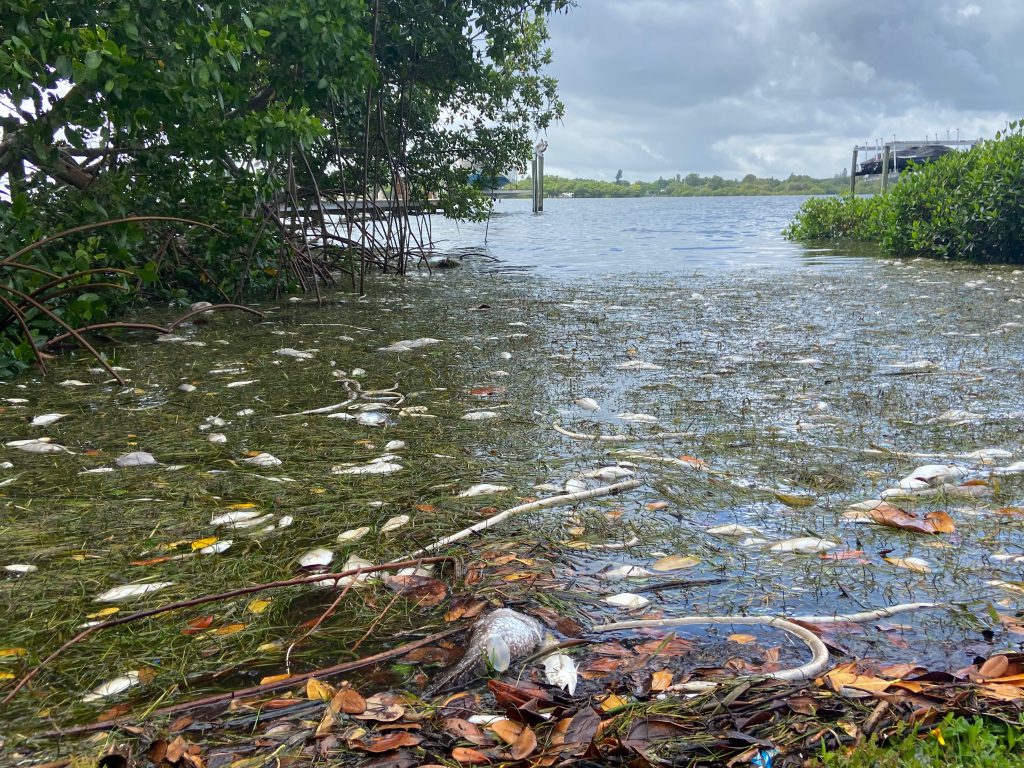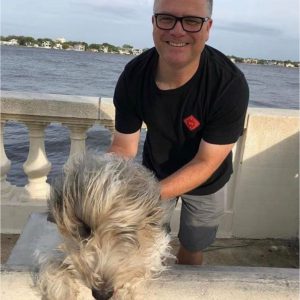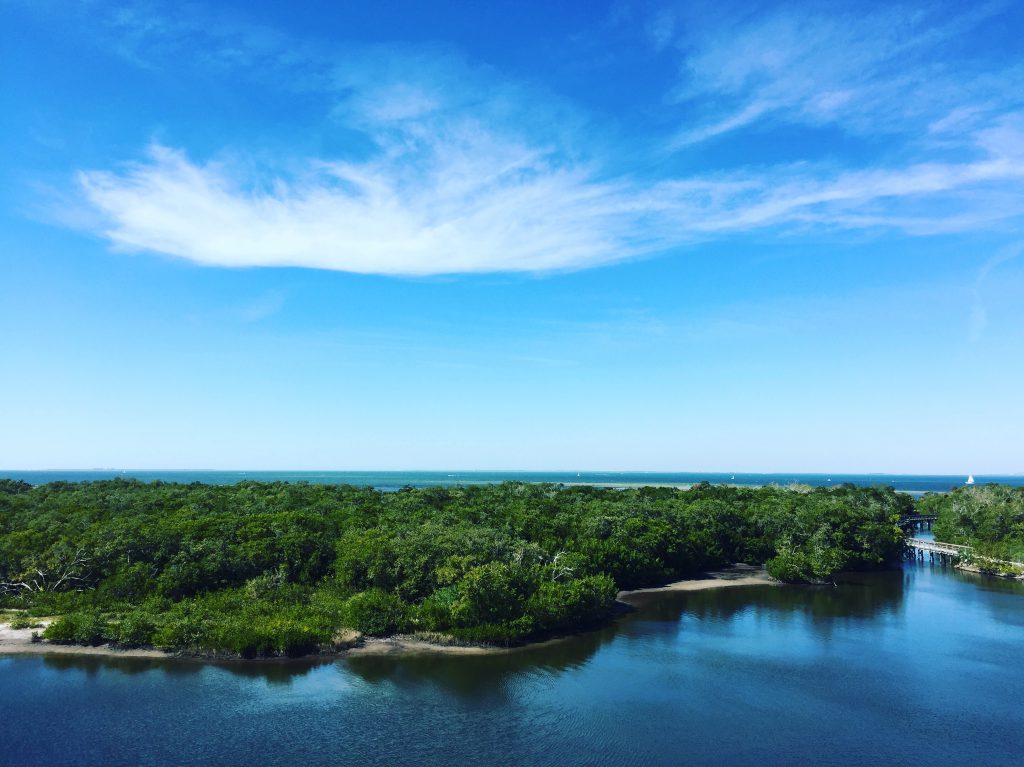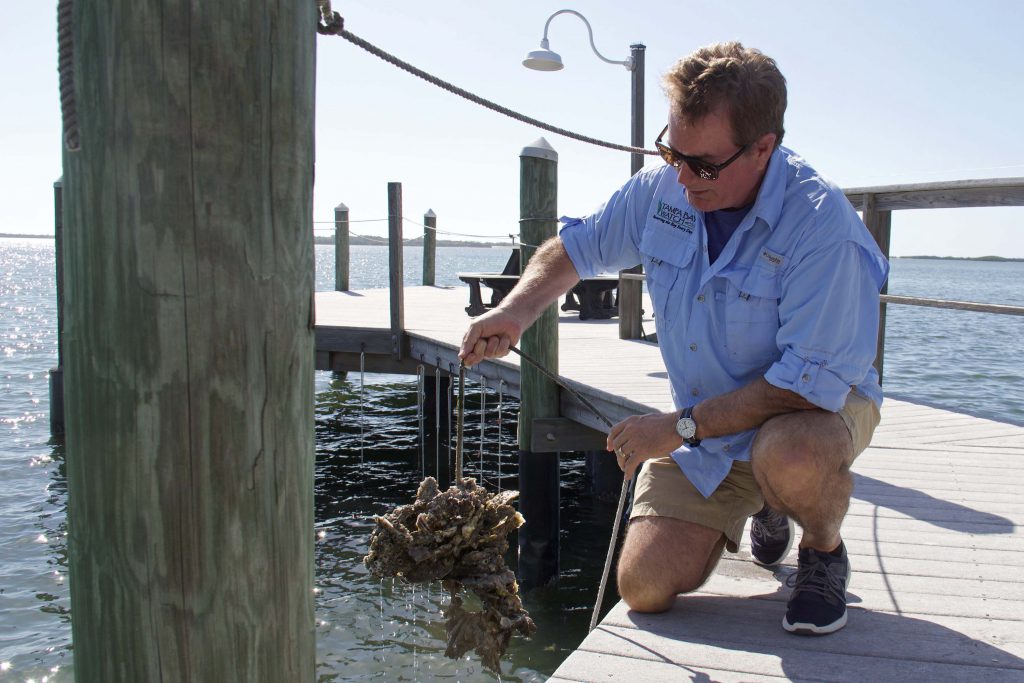After decades of pollution suffocated Tampa Bay and killed half its seagrass and much of its marine life, unprecedented political cooperation and hundreds of science-guided projects brought the estuary back to life. Tampa Bay became a symbol for the success of the Clean Water Act of 1972, and humanity’s ability to clean up pollution. But in the 50th anniversary year of the Clean Water Act, seagrasses and fishes have begun to die again. The Bay is losing ground — again a symbol, this time of declining water quality after a half-century of gains.
The burnt-rotten stench of sulfur hung over Tampa Bay. Socialites living on Bayshore Boulevard, one of the most coveted water-front addresses in the city, watched their silver dishes, silverware and heirlooms tarnish. They knew the culprit was coming from the Bay, but had no idea exactly what it was.
Through much of the 20th century, well into the 1970s, phosphate plants and coal-burning power plants pumped sulfur dioxide into the skies over Tampa Bay without opposition. Industries, farms and local governments dumped waste into the bay and its connecting waterways — even raw sewage.
“It’s some of the nicest real estate in Tampa, and it was almost uninhabitable,” said Evan Bennett, a Florida Atlantic University history professor working on an environmental history of Tampa Bay. “Women along Bayshore in the 1950s and 1960s were complaining regularly that not only did it tarnish the silver — but it would erode silver.”
Activism from those kinds of wealthy homeowners, Bennett said, made politicians take notice of a dying Bay. The pollution ruining the silver was ruining sea life too. Nearly half of the Bay’s seagrasses were wiped out by 1982. The decades that followed saw some of the worst fish kills in Florida history. Manatees reached the brink of extinction.
Political will made Tampa Bay one of the nation’s shining examples of how a region could come together — with local, state and federal government working with citizens, NGOs and industry to clean up water pollution. Unprecedented cooperation over decades culminated in Tampa Bay becoming a national model for restoration and the success of the Clean Water Act.
But today, Tampa Bay is again plagued by fecal and industrial pollution and other dangers. Seagrass levels in the Bay peaked in 2016 at more than 42,000 acres. Now that number has dipped to 35,000 acres. Manatees, which had returned to the Bay alongside seagrass, were taken off the endangered species list in 2017. Now they are dying in record numbers. Algae blooms over the last five years have led to some of the worst fish kills in Tampa Bay since the 1970s.

On the 50th anniversary of the Clean Water Act of 1972, Tampa Bay is still a model for what political will, cooperation and regulation can achieve. It is also an example of the limitations of the half-century-old law amid weak state pollution control; intense population growth; and climate change.
Like other waterways across Florida, Tampa Bay is losing its shine.
Tarnished history: “You didn’t want to go in the water”
In the mid-20th century, phosphate plants were allowed to dump their wastewater into the Alafia River, which flows into Tampa Bay, Bennett said. Municipal sewage plants did little to no cleanup.
“It was sort of level one, throw a little bleach on it,” Bennett said. “And then they would dump it right back out into the canals.”
But resistance to pollution was different in Tampa Bay than in other areas because its governments and industries couldn’t simply push pollution off on poor communities, Bennett said. The Bayshore Boulevard society women demanded an environmental impact study, published in 1969. It documented algae blooms and six feet of sludge trapped on the floor of the estuary.
Tampa Bay saw its worst period of water quality in the 1970s, just as the Clean Water Act was being applied, said Bennett, who grew up just over a mile from the Bay.
“We joked that you didn’t want to go in the water in a lot of places because it was simply too polluted.”

The City of Tampa made history in 1979 with the opening of the Howard F. Curren Advanced Wastewater Treatment Plant, which reduced nitrogen loads into the Bay by 90%. To prove the drastic improvements, Tampa city officials toasted their achievement by drinking the plant’s discharged water from champagne flutes.
But it would take hundreds more projects over decades to bring the Bay back to life. Bennett remembers biking to Ben T. Davis Beach in the 1980s with his older siblings. The wide beachfront — later eroded by Hurricane Elena — was a popular spot for working-class Tampanians.
When he was about five, Bennett said, his sister bought him a snorkeling mask for Davis Beach.
“I remember putting my head in the water and being like really disappointed because I thought having a mask, I’d be able to start seeing all kinds of things,” he said. “The clarity was always really low.”
He mostly remembers the trash, which washed up to litter the shores and got tangled in the mangroves. Beaches around the Bay were sometimes shut down due to fecal pollution warnings. “They were simply looking at Tampa Bay as kind of a sink,” Bennett said.
In 1982, Upper Tampa Bay Conservation Park opened to provide natural areas and a learning center to teach young children about the Bay’s environment. “One time we had a field trip to the causeway, and we took a big dragnet and pulled in everything we could,” Bennett said. “There wasn’t really a whole lot in that net.”
Still, the park was an early step toward remaking a natural bay, he said. “It sort of stands as a turning point in the education about the Bay.”
A national model
In 1991, the U.S. Environmental Protection Agency recognized Tampa Bay as an “estuary of national significance,” clearing the way for a comprehensive management plan for the still-struggling Bay. The nation’s estuary programs — there are 28 nationwide, including four in Florida — are funded by the Clean Water Act. Later that decade, the Tampa Bay Estuary Program became an independent special district of Florida, allowing it to build collaboration between public and private sectors in the Tampa Bay region.
Maya Burke, assistant director for the TBEP, says this collaboration since 1998 has helped keep everyone on the same page.
“We spell out line by line, all of the things that our partners are interested in doing,” she said. “And it has to be unanimously approved and adopted by all of those entities who sit around our table.”
Every five years, the program gathers officials in the community to rework its Interlocal Agreement, which guides the next half-decade of work cleaning up the Bay.
“There’s real value in taking the time to express those things and, you know, being real clear about our commitments to each other,” Burke said.
In her nearly two decades in the field, she said moderate politics and water ethics have allowed community leaders to stretch across the aisle for the good of the estuary. The EPA has heralded TBEP as “a model for similar efforts by other community-based programs.”
Indeed, Bennett attributes many of Tampa Bay’s water-quality successes to collaboration between advocates and politicians — something that isn’t often seen at the state level.
“I think Tampa Bay is lucky to this extent that the activism around it started in the 1960s and ‘70s, while there was still a significant chunk of bay,” he said. “There was also a political moment where environmentalism was something both parties latched onto.”

All in all, TBEP has funded hundreds of projects in its three decades, from research to restoration to “mini grants” that get the community involved in renewing the Bay. The results have been dramatic. The program’s Nitrogen Management Consortium, a public-private partnership of key cities and industries bordering the bay, reduced nitrogen flowing into the bay by more than 400 tons in one decade even as the region’s population grew by nearly a million people.
As nitrogen levels decreased, seagrasses grew back. Seagrass coverage, which had plummeted to near 20,000 acres by 1982, doubled to 40,000 acres by 2016.
Over the past two years, however, seagrasses have begun to die back again. Last summer and fall saw what scientists described as the worst red tide outbreak and fish kills the bay had seen since the early 1970s. Earlier this year, Florida’s Harmful Algal Bloom Task force warned that “without hard work and careful planning, the challenges created by harmful algal blooms are likely to worsen due to the influences of other environmental stressors associated with climate change and Florida’s growing population.”
Continuing pollution threats
If you stand on Bayshore Boulevard today and look east across the Bay, you’ll see two mountain tops on the otherwise flat Florida landscape. These are mounds of radioactive phosphate waste, called “gypstacks,” with huge lagoons on top full of radioactive wastewater too dangerous to dispose of. These stacks, at Riverview, stand as reminders that the industry’s waste can pollute indefinitely.
Across the Bay to the south in Manatee County last year, officials detected a leak in the wall that holds back polluted water at the Piney Point phosphate mine, which shut down 20 years ago, and pumped more than 200 million gallons into Tampa Bay to reduce pressure and avoid a worse disaster.
Earlier this month, scientists from TBEP, the University of Florida, the University of South Florida and others published new research showing that the spill, in sending a year’s worth of nutrients into the Bay over 10 days, “may have created conditions in Tampa Bay conducive for the extreme bloom concentrations.”
Like other parts of Florida, Tampa Bay must cope with such “legacy pollution” on top of new threats associated with population growth and climate change. Rising temperatures are causing more-extreme rains and storms, which in turn worsen floods that carry pollution to waterways. In the years since the Clean Water Act, so-called “non-point source pollution,” namely stormwater runoff from residential and agricultural nutrients, has become the single-largest source of nitrogen in Tampa Bay — and into many waterways across the nation.
Tamara Pierson, water issues co-chair for the Tampa Bay Sierra Club, says that septic tanks are a particular scourge. Pierson has lived in Tampa since 2004, and while the stench isn’t as strong as it used to be, she still catches the occasional whiff.
“When I first came here, it stunk like an outhouse and I was always like, ‘What is that?’” she said. “It smells like poop, but it couldn’t really be. And come to find out it is.”
There are 120,000 septic tanks in Hillsborough County, which contain nitrogen levels 65 times that of Tampa’s sewage-treatment waste. This septic waste seeps into the groundwater, which makes its way into the aquifer — a major source of Florida’s drinking water.
“And you’re really just throwing all of the human waste — urine and feces — into the water,” she said. “It’s just disgusting.”
Lindsay Cross, who spent 14 years at TBEP and is running for a state House seat, said the Bay area has started moving away from septic systems, but many are still around.
“They’re still our septic systems,” she said. “And they fail.”
Cross called for a statewide septic inspection program, which has been proposed and shot down by the Florida Legislature for years. Septic inspections bills haven’t made it to a single committee hearing.
“It’s not for lack of people trying or knowing the right things to do,” Cross said. “It’s because there hasn’t been the political will to do it.”
She cited added costs to taxpayers, local government and developers as the biggest roadblock to the legislation passing.
“The more we delay this, the more it’s going to hit us in our pocketbooks later,” Cross said. “And in the meantime, we’ll see the quality of our life decrease.”
Thomas Hallock, founder of the nonprofit Friends of Salt Creek and a professor of English who works on environmental humanities at the University of South Florida in St. Petersburg, said despite local and regional successes, it’s difficult to keep the Bay pristine given reluctance to regulate pollution during the administrations of former Gov. Rick Scott and current Gov. Ron DeSantis.
“Their policies literally wash up on our shores,” he said.
It’s no secret Florida struggles to balance growth and development with environmental protection. But Cross said the balance got out of whack after the Scott Administration eliminated Florida’s Department of Community Affairs, which oversaw cities’ growth and development planning.
Some of the worst pollution and algae blooms in the Bay, Cross said, are in east Hillsborough and Manatee counties, where urban sprawl has taken off. “When you have more people, you have more pollution,” she said.
The root problem in Florida environmental policy, she said, is “the failure to adopt more aggressive laws.”
“That’s one of the most damaging things that has happened — intentionally — in recent years,” she said.
The estuary program and an aging advocate population
Bennett said balancing the environment and development has been key to the collaborative spirit in the Bay. “The phosphate industry is a really important industry and you’re never going to get rid of the port,” he said. “Nor are you going to really get rid of development.”
With Tampa Bay’s rich advocacy network and involved citizens, he said, the cooperation can continue to lead to progress. “It was everyday people, people who like to go to Ben T. Davis Beach, people who like to go out on the Gandy and pull out their chair in the afternoon and go crabbing,” he said. “They own that Bay as much as anybody else.”
Bennett cited the nonprofit Tampa Bay Watch as the kind of powerful advocacy organization that serves as a watchdog and draws citizens to work on the Bay. “They are out there watching like hawks.”
Peter Clark, founder of Tampa Bay Watch, has worked since the early 1990s to help clean up the Bay’s water quality. The nonprofit’s mission is that it “trains and organizes citizen volunteers” to protect the watershed.
“As a scientist, you live and learn from these problems and solutions in the Bay,” Clark said. “But as a fisherman and an environmentalist, you hate to see that level and impact occur in your backyard.”

Backyards are where many of Tampa Bay’s advocates have always been watching from. Bennett said the Bay’s activism over the many decades traces back to the grassroots. Now, he, Burke and others worry that the advocacy population is aging.
“A lot of the people that have been doing this work and have spent 30 years or more working together, they’re starting to retire now,” Burke said. “We have to make sure that we don’t lose that kind of magic of how to work together.”
Hallock agreed that “there’s an old guard aging out.” But he points to a rising generation, including Burke, who have dedicated their lives to cleaning up the Bay. Hallock and other Florida environmental scholars call them “Marjorie’s,” paying homage to Florida’s history of women environmental activists like Marjory Stoneman Douglas, who helped save the Everglades, and Marjorie Harris Carr, who helped stop the Cross Florida Barge Canal half a century ago.
“I do think in this 20s and 30-somethings crowd, that there’s a whole generation of Marjorie’s out there,” Hallock said. “Who really have both a professional commitment, but then also have a private commitment and it really extends well beyond earning a paycheck.”
Though Tampa Bay has suffered all kinds of wounds like silver-tarnishing toxins and recent waste spills like Piney Point’s, it survives due to a community of advocates, researchers and government staff who listen to each other. The same can’t be said for many other areas of Florida, Bennett said.
“If you look at Indian River Lagoon, every time I see the reporting from there I want to bang my head into the wall,” he said. “A lot of the lessons that could have been learned from Tampa Bay were not applied.”
This story is part of the UF College of Journalism and Communications’ series WATERSHED, an investigation into statewide water quality marking the 50th anniversary of the Clean Water Act, supported by Pulitzer Center’s nationwide Connected Coastlines reporting initiative.
 WATERSHED
WATERSHED